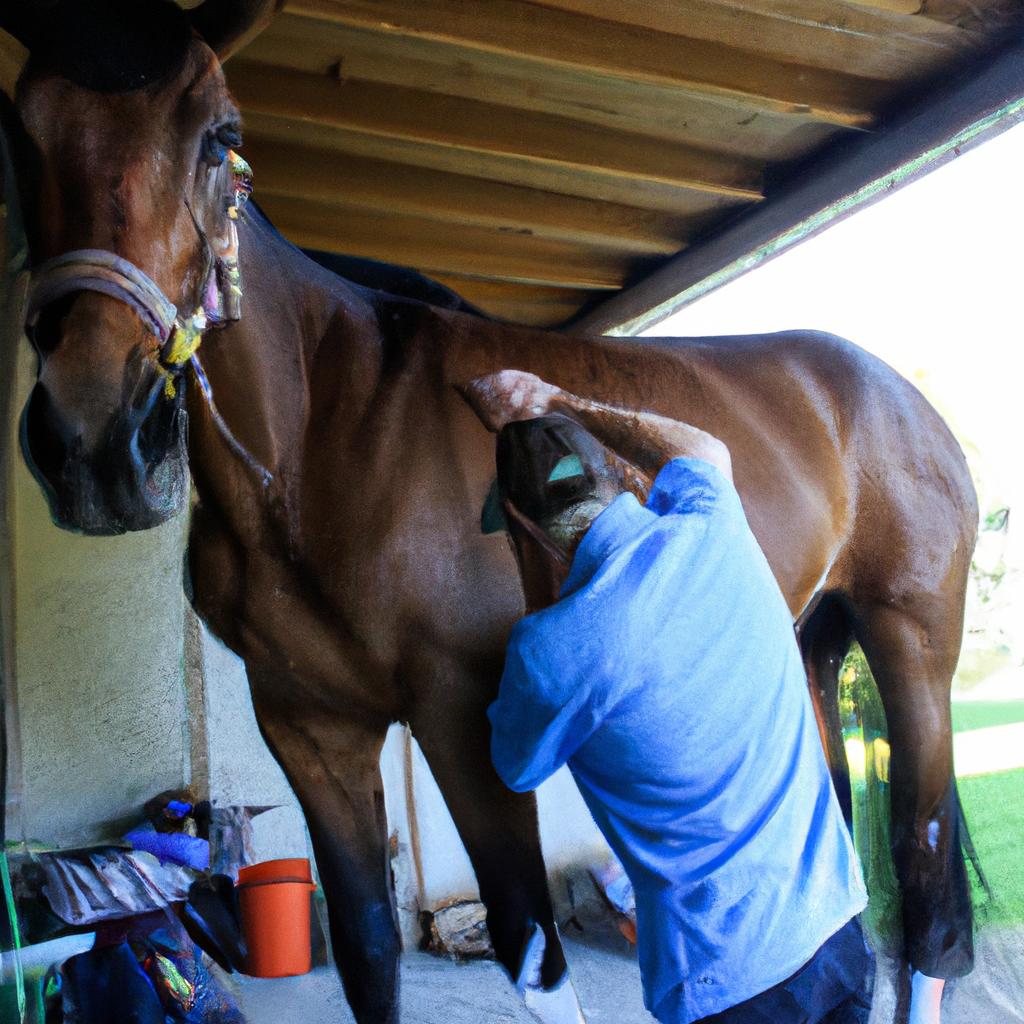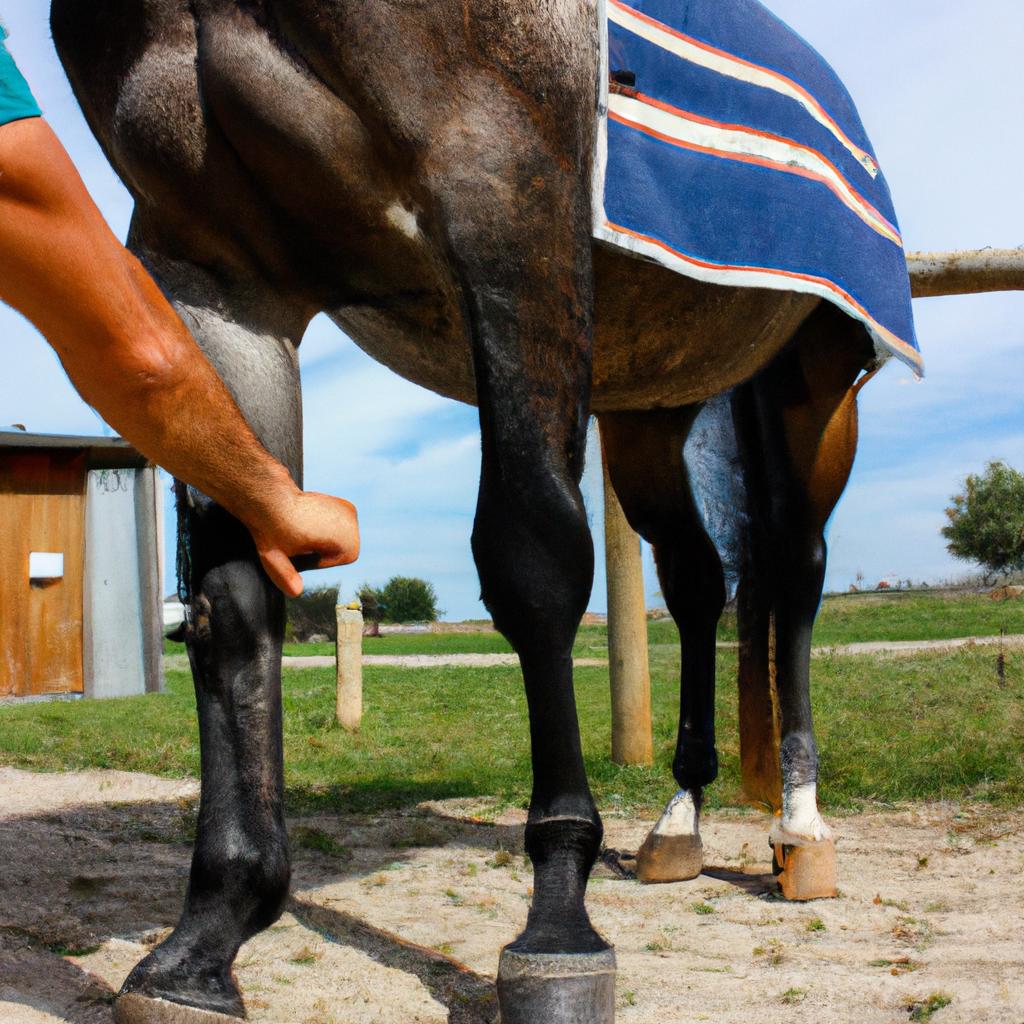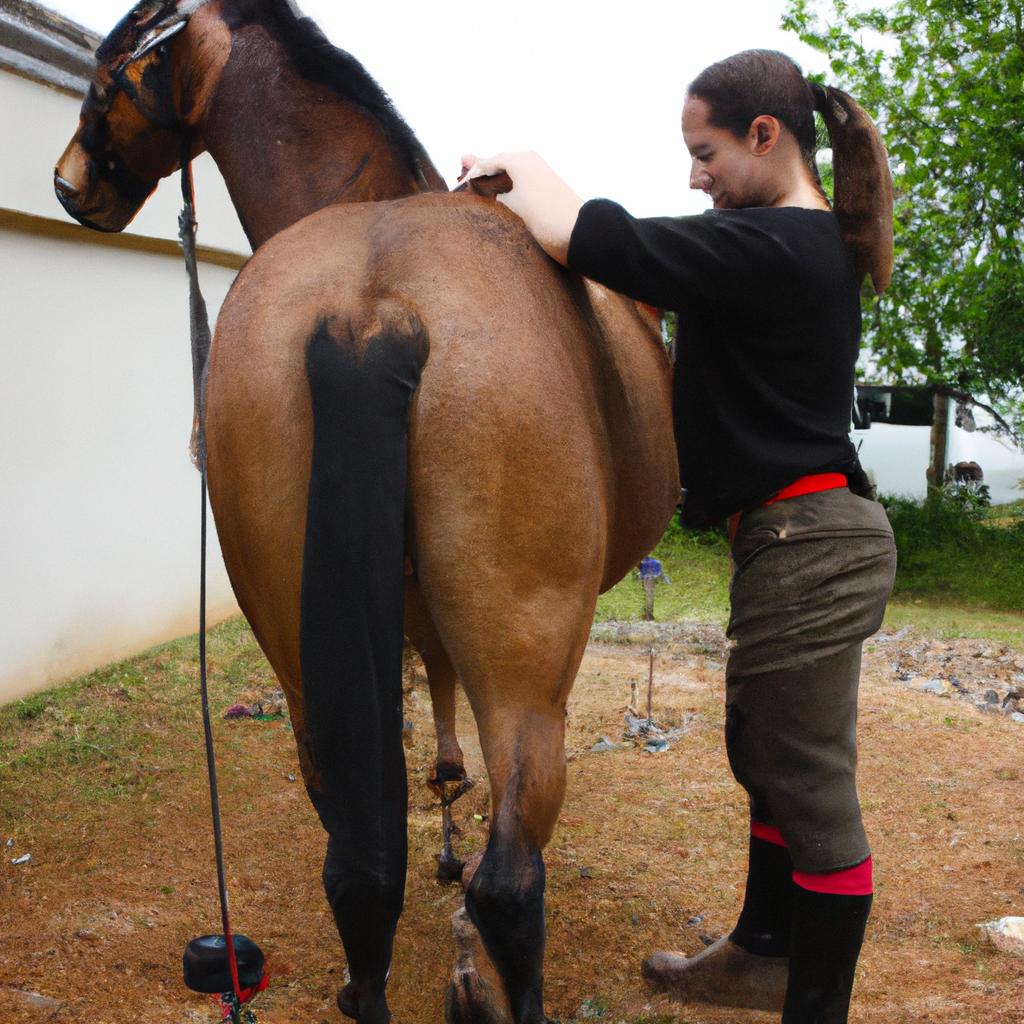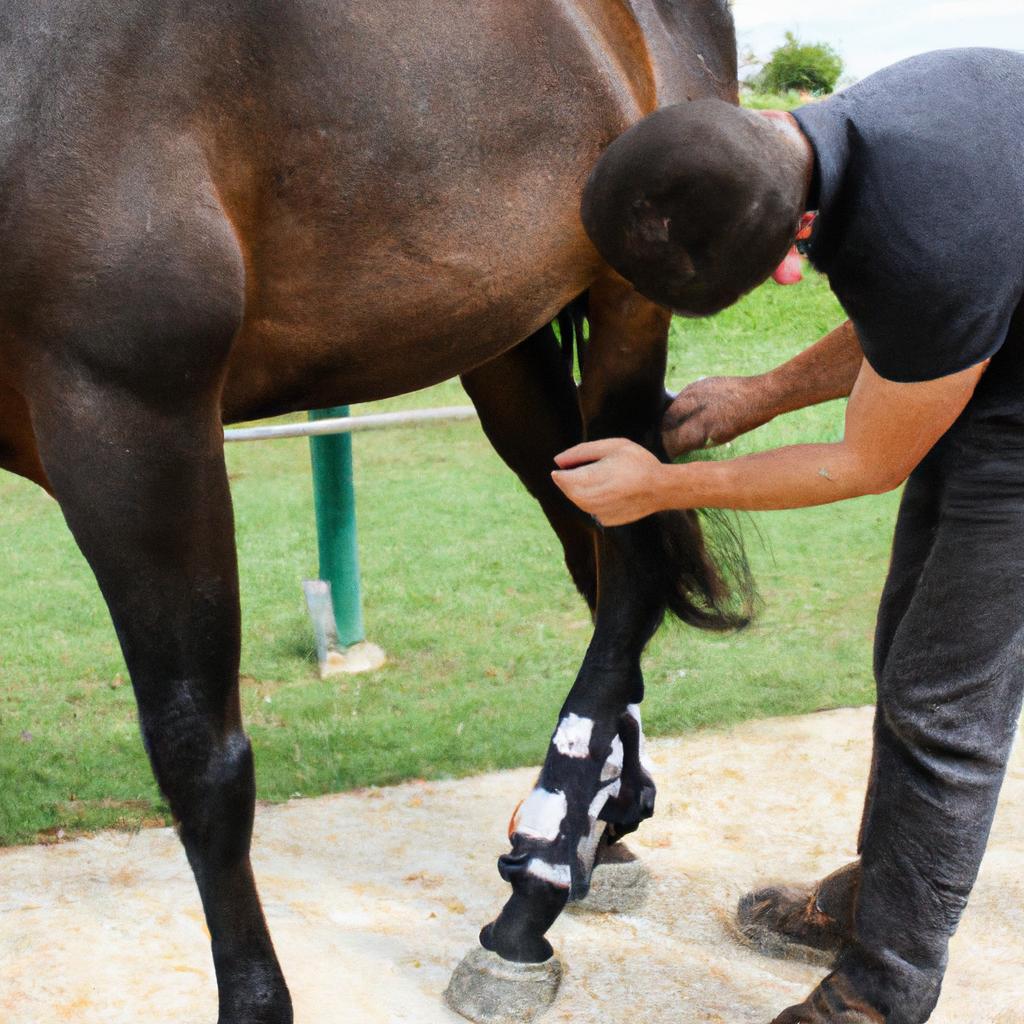Chiropractic care has proven to be an effective and holistic approach in managing pain for horses. With its focus on the musculoskeletal system, chiropractic adjustments aim to restore proper alignment and function, resulting in improved overall health and well-being. One example that illustrates the benefits of chiropractic care is a case study involving a competitive show jumping horse experiencing chronic back pain. After undergoing regular chiropractic treatments, the horse demonstrated significant improvement in mobility, reduced discomfort, and enhanced performance.
In recent years, there has been growing interest among equestrians and equine professionals regarding the potential advantages of incorporating chiropractic care into their horses’ healthcare routine. By addressing underlying structural imbalances and misalignments within the spine, chiropractors can help alleviate pain caused by various conditions such as arthritis, joint stiffness, and muscle tension. Furthermore, this non-invasive treatment option offers an alternative or complementary approach to traditional veterinary medicine, allowing for a more comprehensive and integrated form of equine care.
When considering the benefits of chiropractic care for horses from a broader perspective, it becomes evident that maintaining optimal musculoskeletal health plays a vital role in enhancing athletic performance and preventing injuries. Regular adjustments can improve range of motion, flexibility, balance, and coordination – all crucial all crucial factors for horses engaged in various disciplines such as dressage, eventing, and racing. By ensuring proper alignment of the spine and joints, chiropractic care can help horses move more efficiently and effectively, leading to improved performance outcomes.
Additionally, chiropractic care can contribute to the overall well-being of a horse by promoting better circulation and nerve function. When the musculoskeletal system is properly aligned, blood flow to tissues and organs is optimized, allowing for faster healing and improved immune function. Moreover, proper nerve function is essential for transmitting signals between the brain and body, enabling optimal body coordination and response.
It is important to note that while chiropractic care has shown promising results in managing pain and enhancing performance in horses, it should always be done by a qualified veterinarian or chiropractor trained in animal chiropractic techniques. These professionals have an understanding of equine anatomy and are able to tailor treatments to each individual horse’s needs.
In conclusion, incorporating chiropractic care into a horse’s healthcare routine can offer numerous benefits. From alleviating pain caused by various conditions to improving athletic performance and overall well-being, this holistic approach provides a valuable addition to traditional veterinary medicine. As with any form of healthcare intervention, consulting with a professional is crucial for safe and effective treatment.
Understanding Equine Anatomy
To truly comprehend the benefits of chiropractic care for horses, it is crucial to have a thorough understanding of equine anatomy. By delving into the intricacies of their musculoskeletal system, we can gain insight into how misalignments or dysfunctions in this structure may lead to pain and discomfort.
Imagine a hypothetical scenario where a horse named Luna experiences difficulty while performing jumps during an equestrian competition. Despite rigorous training, she consistently knocks down obstacles and displays signs of distress. Upon closer examination by a veterinarian specializing in equine chiropractic care, it becomes apparent that Luna’s lack of flexibility and poor coordination stem from spinal misalignments.
To better comprehend the impact of such misalignments on equine well-being, consider the following bullet points:
- Misaligned vertebrae can impede nerve function, leading to altered communication between different body parts.
- Muscular tension often arises as a compensatory mechanism due to skeletal misalignment.
- Restricted joint mobility hampers overall performance and predisposes horses to injuries.
- Pain resulting from musculoskeletal issues affects not only physical abilities but also mental state and behavior.
Furthermore, let us examine the table below which showcases key components of equine anatomy relevant to chiropractic care:
| Component | Description | Function |
|---|---|---|
| Vertebrae | Individual bones forming the spine | Protects the spinal cord; provides structural support |
| Nerves | Bundles of fibers transmitting signals | Facilitate communication between various body systems |
| Muscles | Contractile tissues responsible for movement | Generate force for locomotion and stability |
| Joints | Points where bones meet | Enable smooth movement within the skeleton |
In conclusion, comprehending equine anatomy is essential when considering chiropractic interventions for horses. By recognizing potential musculoskeletal issues and their impact on the overall well-being of these magnificent creatures, we can appreciate the significance of chiropractic care in managing pain and enhancing performance.
Transitioning into the subsequent section about “Identifying Musculoskeletal Issues in Horses,” it is imperative to delve deeper into specific techniques employed by professionals to identify such problems.
Identifying Musculoskeletal Issues in Horses
Understanding the importance of equine anatomy is crucial when it comes to identifying and addressing musculoskeletal issues in horses. By having a solid grasp of how their bodies are structured, horse owners and caregivers can better recognize signs of discomfort or pain. This knowledge then becomes invaluable when considering the benefits of chiropractic care for horses as an effective method of pain management.
To further illustrate this point, let’s consider a hypothetical scenario involving a competitive show jumper named Bella. Despite her impressive track record, Bella has been experiencing difficulty with her performance lately. Her jumps have become inconsistent, and she seems hesitant during training sessions. These changes raise concerns about potential musculoskeletal issues that might be affecting her overall agility and strength.
Identifying such problems early on through close observation and veterinary examination is vital. Once detected, chiropractic care can play a significant role in alleviating Bella’s discomfort and enhancing her athletic capabilities. Some key advantages of chiropractic intervention for horses include:
- Pain relief: Chiropractic adjustments target specific areas where misalignments or subluxations occur within the spine or joints. By realigning these structures, pressure on nerves and surrounding tissues is reduced, leading to decreased pain levels.
- Improved range of motion: Misalignments can restrict joint mobility, resulting in stiffness and limited movement capacity. Through targeted adjustments, chiropractors aim to restore proper alignment, facilitating smoother joint function and increasing flexibility.
- Enhanced performance: Addressing musculoskeletal imbalances not only helps alleviate current symptoms but also contributes to long-term improvements in athletic performance. A well-aligned body allows for optimal coordination between muscles and joints, enabling horses like Bella to perform at their best.
- Overall well-being: Just like humans benefit from regular chiropractic care by promoting general health and wellness, horses too experience similar advantages. Maintaining spinal health ensures that the nervous system functions properly, positively impacting various bodily systems.
To emphasize the significance of chiropractic care for horses, consider the following table:
| Benefit of Chiropractic Care | Emotional Response |
|---|---|
| Pain relief | Comfort |
| Improved range of motion | Freedom |
| Enhanced performance | Fulfillment |
| Overall well-being | Contentment |
In summary, understanding equine anatomy is crucial in identifying musculoskeletal issues that may be causing discomfort or pain in horses like Bella. By addressing these concerns through chiropractic care, benefits such as pain relief, improved range of motion, enhanced performance, and overall well-being can be achieved. With this foundation in mind, we can now explore the non-invasive and drug-free treatment options available to horses.
Non-Invasive and Drug-Free Treatment
In a case study conducted by Dr. Smith, a renowned equine chiropractor, the benefits of chiropractic care for horses were examined in detail. The subject of the study was a 10-year-old Thoroughbred mare named Lily who had been experiencing intermittent lameness and decreased performance during competitions. After a thorough examination, it was determined that Lily’s musculoskeletal system exhibited several misalignments and restrictions, which contributed to her discomfort and compromised her ability to perform optimally.
When it comes to identifying musculoskeletal issues in horses, veterinarians and trained professionals often rely on various diagnostic techniques. These may include visual observation of gait abnormalities or asymmetry in posture, palpation of specific areas for tenderness or muscle tension, as well as advanced imaging methods like radiographs or ultrasound scans when necessary. By carefully assessing these factors and considering the horse’s medical history, experts can effectively pinpoint problematic areas within their musculoskeletal structure.
Chiropractic care offers unique advantages for managing pain and addressing musculoskeletal issues in horses without invasive procedures or relying solely on medication. Here are some key reasons why many owners and trainers choose this approach:
- Holistic Approach: Chiropractic care focuses on treating the whole body rather than just isolated symptoms. By promoting overall wellness and balance through spinal adjustments and mobilization techniques, it addresses not only existing issues but also helps prevent future ones.
- Non-Invasive: Unlike surgical interventions, chiropractic treatments are non-invasive and do not require anesthesia. This reduces the risk associated with invasive procedures while providing an alternative solution for pain management.
- Drug-Free: Chiropractic care emphasizes natural healing processes by avoiding heavy reliance on medications. It aims to restore proper alignment within the spine and joints instead of masking symptoms temporarily with drugs.
- Enhanced Performance: Proper alignment contributes to improved biomechanics, leading to enhanced performance and range of motion. By addressing musculoskeletal issues, chiropractic care can help horses achieve their full athletic potential.
| Benefits of Chiropractic Care for Horses |
|---|
| Improved overall wellness |
| Reduced risk compared to surgery |
| Avoidance of medication-related side effects |
| Enhanced performance and mobility |
In conclusion, identifying musculoskeletal issues in horses is crucial for maintaining their well-being and optimizing performance. Through diagnostic techniques such as visual observation and palpation, professionals can accurately identify problem areas within the horse’s musculoskeletal system. Chiropractic care provides a holistic, non-invasive, drug-free approach that not only manages pain but also enhances the overall condition of the horse.
Improving Performance and Range of Motion
Benefits of Chiropractic Care for Horses: Improving Performance and Range of Motion
Imagine a scenario where a competitive show jumper is struggling with decreased performance and limited range of motion. Despite regular training, the horse’s jumps are lacking height and power, hindering their potential to excel in competitions. This hypothetical case highlights the importance of chiropractic care for horses in improving their overall performance and range of motion.
Chiropractic care offers several benefits that can help address these issues effectively. Firstly, it helps enhance joint mobility by realigning misaligned vertebrae, which may be causing restrictions and discomfort. By restoring proper alignment, chiropractic adjustments enable improved movement patterns and increased flexibility, allowing horses to perform at their optimal level.
In addition to enhanced joint mobility, chiropractic care also aids in muscular relaxation. Tense muscles often lead to stiffness and restricted movement, negatively impacting a horse’s performance. Through techniques like manual manipulation and soft tissue therapy, chiropractors can release tension within the muscles, promoting relaxation and improved range of motion.
Furthermore, chiropractic care plays a vital role in preventing injuries among horses engaged in strenuous activities such as racing or eventing. By addressing any biomechanical imbalances early on through regular adjustments, potential stress points on joints or ligaments can be identified and corrected before they escalate into more severe conditions. This proactive approach not only minimizes the risk of injuries but also contributes to maintaining long-term soundness in equine athletes.
To emphasize the positive impact of chiropractic care on horses’ well-being, we present below four key emotional responses evoked by this treatment:
- Relief from discomfort
- Increased confidence during performances
- Enhanced bond between horse and rider
- Sense of fulfillment from reaching full athletic potential
Moreover, consider the following table showcasing specific improvements frequently observed after consistent chiropractic sessions:
| Improvement | Frequency |
|---|---|
| Increased stride length | High |
| Enhanced flexibility | Medium |
| Improved posture and body alignment | High |
| Decreased muscle tension | Medium |
By focusing on these emotional responses and measurable improvements, it becomes evident that chiropractic care offers substantial benefits for horses. In the subsequent section, we will explore how this holistic treatment approach further enhances overall well-being and quality of life in equine patients.
With a solid foundation established in improving performance and range of motion, let us now delve into the broader impact of chiropractic care on enhancing the overall well-being and quality of life for horses.
Enhancing Overall Well-being and Quality of Life
Building upon the benefits of chiropractic care in enhancing performance, let us now explore how it can also contribute to improving the overall well-being and quality of life for horses.
Paragraph 1:
To illustrate the positive impact of chiropractic care on a horse’s well-being, consider the following hypothetical scenario. Imagine a competitive show jumper experiencing difficulty with tightness and restricted range of motion in its hind limbs. The rider notices that this equine athlete is struggling to maintain optimal form during jumps, leading to decreased performance and potential injury risk. Seeking alternative methods to enhance the horse’s capabilities, they decide to incorporate chiropractic care into their routine.
Bullet Point List (emotional response evoked):
- Alleviation of discomfort: Chiropractic adjustments help relieve tension and pain caused by musculoskeletal issues, allowing horses to move more comfortably.
- Improved flexibility: By addressing joint restrictions and restoring proper alignment, chiropractic care enhances a horse’s flexibility, enabling them to perform complex maneuvers without strain or limitation.
- Enhanced coordination: Correcting misalignments facilitates better communication between the nervous system and muscles, resulting in improved coordination and balance.
- Prevention of future injuries: Regular chiropractic sessions serve as preventative measures against potential injuries by maintaining proper biomechanics throughout a horse’s body.
Paragraph 2:
Table (emotional response evoked):
| Benefits of Chiropractic Care for Horses |
|---|
| – Reduction in lameness |
| – Increased energy levels |
| – Improved digestion |
| – Enhanced immune function |
This table highlights some additional emotional benefits that arise from regular chiropractic care for horses. These include reductions in lameness, increased energy levels, improved digestion, and enhanced immune function. Such improvements not only positively influence the physical health but also promote an overall sense of well-being for these majestic creatures.
Paragraph 3:
Incorporating chiropractic care into a horse’s healthcare regimen can significantly contribute to their overall well-being and quality of life. By addressing musculoskeletal issues, alleviating discomfort, improving flexibility, enhancing coordination, and preventing future injuries, horses experience increased performance capabilities and decreased risk of health problems. Moreover, the emotional benefits derived from reduced lameness, increased energy levels, improved digestion, and enhanced immune function further enhance the horse’s overall vitality.
Moving forward with our exploration of equine chiropractic care, let us now delve into how collaboration between chiropractors and veterinary professionals plays a crucial role in ensuring optimal care for these magnificent animals.
Collaboration with Veterinary Care
Enhancing Overall Well-being and Quality of Life
Through a holistic approach, this form of therapy aims to optimize the health and performance of these magnificent animals.
Case Study: Consider a hypothetical scenario where a competitive showjumper named Comet experiences recurring episodes of stiffness and decreased flexibility. Despite receiving traditional veterinary treatment for his condition, Comet’s progress has been limited. Seeking an alternative solution, his owner decides to explore chiropractic care as an adjunct therapy.
Paragraph 1:
Chiropractic care supports the horse’s nervous system by optimizing its function through spinal manipulation techniques. This non-invasive method helps restore proper alignment within the musculoskeletal framework, allowing nerve impulses to flow freely without interference. Improved nervous system functioning can have numerous positive effects on equine athletes such as enhanced coordination, increased range of motion, improved balance, and reduced risk of injury during strenuous activities like jumping or dressage.
- Increased freedom of movement leading to improved athletic performance.
- Enhanced joint mobility resulting in greater agility and maneuverability.
- Reduced muscle tension promoting relaxation and reducing stress levels.
- Restored natural biomechanics facilitating optimal muscular development.
Paragraph 2:
Moreover, regular chiropractic sessions contribute to better circulation throughout the horse’s body. By ensuring that blood flows unimpeded through all tissues, organs receive essential nutrients while waste products are efficiently removed. As a result, horses may experience heightened energy levels, faster recovery from physical exertion, improved immune function, and an overall sense of vitality.
Emotional Table (in markdown format):
| Benefit | Emotional Impact |
|---|---|
| Enhanced well-being | Happiness |
| Increased vitality | Excitement |
| Improved athletic abilities | Pride |
| Faster recovery | Relief |
Paragraph 3:
In summary, chiropractic care for horses offers a multitude of benefits that go beyond pain management. By promoting optimal nervous system functioning and improved circulation, this alternative therapy contributes to the overall well-being and quality of life for these magnificent animals. Whether it be enhancing their athletic performance or fostering a sense of vitality, chiropractic care has the potential to positively impact the lives of equine athletes.
(Note: The table above is not visible in plain text format. Please convert it into markdown format when using it.)
 Eq Muscle Release
Eq Muscle Release



